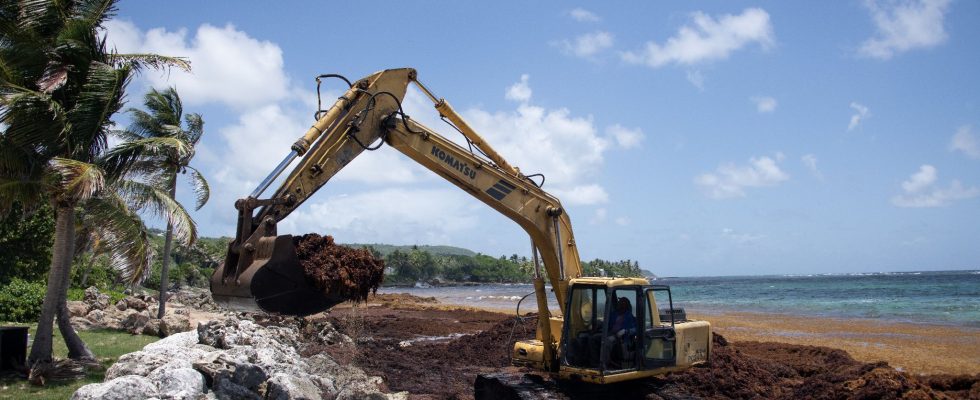“2023 is a dark year.” Sylvie Gustave-dit-Duflo, vice-president of the Guadeloupe region, is not one to get carried away for no reason. Also president of the French Office for Biodiversity, she is sounding the alarm in the face of the grounding of Sargassum seaweed on the beaches of the Caribbean, “a phenomenon that is going crescendo, with ever-increasing quantities, she insists. We are in the process of collecting tonnages three times greater than an average year.”
Anyone who lives in Guadeloupe or Martinique, or has only ever set foot there, very quickly understands the ordeal that the local populations live with in the face of Sargassum. Impossible to miss their brownish color and the nauseating smell of rotten eggs which contrasts with the shimmering landscapes of the Caribbean. When they are at sea, these algae are however harmless, and are even precious reservoirs of biodiversity. But since 2011, their massive stranding on the beaches has been a scourge for the region.
Economic scourge, first, with a loss for tourism estimated at 92 million euros in 2022 by Caricom, an international organization in the Caribbean. At the level of the municipalities, the permanent collection of algae is also a budgetary abyss: for Capesterre-de-Marie-Galante for example, a small municipality of 3,200 inhabitants particularly affected, the bill could rise from 800,000 to 1.5 million euros for this year.
If the municipalities of Guadeloupe and Martinique are busy collecting these algae, it is also because Sargassum presents a significant health risk. As they decompose on the beaches, they release around thirty gases, two of which are particularly toxic: hydrogen sulphide and ammonia. According to a study by the Martinique University Hospital, these sargassum would even increase the risk of diseases in pregnant women and their children, in particular preeclampsia or premature births. And if that weren’t already enough, the colossal grounding of Sargassum algae also presents a very significant danger for the environment: their accumulation suffocates coral reefs and seriously affects ecosystems.
The difficult valuation of sargassum
Faced with this proliferation, an idea quickly gained ground: why not use Sargassum seaweed as a raw material? “Sargassum can become a tremendous source of economic opportunities, if we find how to value them”, declared Edouard Philippe in his Prime Minister’s costume in October 2019, when he went to Guadeloupe for the first international conference at this subject.
“We must add value to sargassum. As long as we do not know what to do with it, there will be no solution to the problem”, wants to believe Pierre-Antoine Guibout, Breton of origin, but residing in Saint -Barthélemy, an island also affected by these algae. In 2019, he embarked on Sargasse Project, with a simple idea: use the cellulose present in the seaweed to try to make paper and packaging. “From trial to trial, I managed to produce a first cardboard project sheet in a very artisanal way. This is where the project was really born”. But between the idea and the actual design, there is a long way to go. Firstly because the sargassum must be “clean”. Understand: neither too sandy nor decomposed. The best solution remains to capture it at sea. But faced with the quantities of algae currently pouring out day by day, boats are lacking.
The main problem with Sargassum is actually in their very nature. They are indeed loaded with toxic heavy metals, such as arsenic, lead or mercury. Enough to make the transition to fertilizer impossible, a recovery considered for a time. And this, without even taking into account the ability of Sargassum seaweed to take on… chlordecone, this pesticide which massively contaminated the West Indies at the end of the 20th century. A renewable energy producer has also tried using Sargassum seaweed as a vegetable charcoal and biomass energy source. But the salt present in the seaweed ended up severely degrading the boilers, which derailed the project.
Every solution comes with its own set of problems. “In France, recovery is difficult because we have drastic health standards. When you compare with Mexico, it has nothing to do: there, they pick up algae barefoot, without a mask. Here, it’s not like that. We can’t value it just any way.”, summarizes Sylvie Gustave-dit-Duflo. However, Pierre-Antoine Guibout assures us: “more than two or three green lights from our laboratories”, and Sargasse Project will see the light of day.
Fighting the source of the problem
If these projects can make it possible to envisage a way out, other voices suggest turning the problem around. Failing to be able to manage the crazy quantities of sargassum flowing on the beaches, why not try to reduce them? The government launched a new project last year, the Sargasso II plan, with nearly 36 million euros invested until 2026 to support local authorities in the West Indies. Among the main solutions tested, the construction of deviant dams “near the coast”, in order to divert algae from the beaches.
Insufficient, according to Sylvie Gustave-dit-Duflo: “We must bring an international dimension to research on Sargassum, to give scientists the means to understand their proliferation and to be able to destroy their reservoirs at sea. As long as they are not destroyed, we will be subject to these Sargassum impacts.” Because still today, the origin of the extreme proliferation of these algae since 2011 does not reach consensus. Several leads, such as the warming of the oceans or the supply of nutrients from the Amazon, linked to deforestation and intensive agriculture, have not yet been confirmed. Once the cause has been identified, this could help to better contain the problem.
And it is still far from having reached its peak. “Hotspots of biodiversity could turn into deserts. However, it is this very rich ecosystem that feeds people, which protects them against climatic hazards”, worries Sylvie Gustave-dit-Duflo. For the nearly 800,000 French people who live in Guadeloupe and Martinique, the consequences are already being felt.
